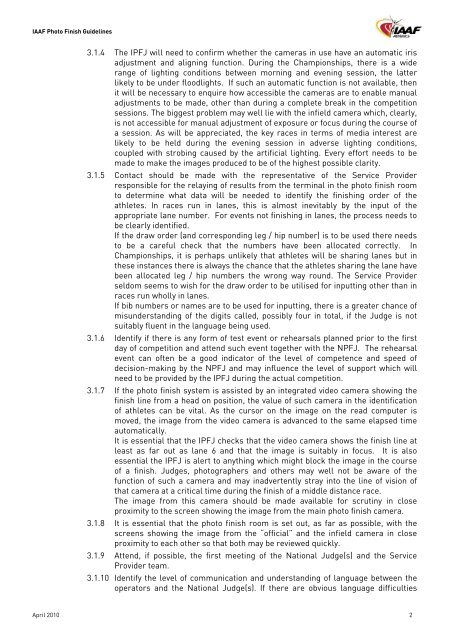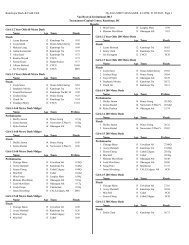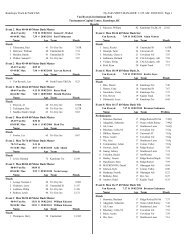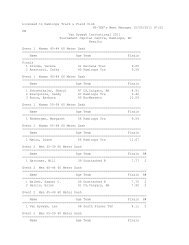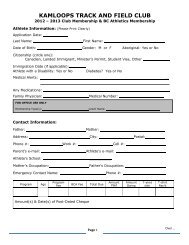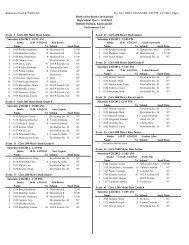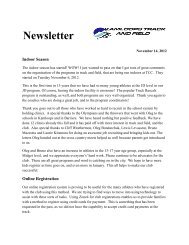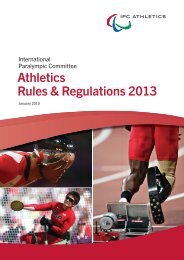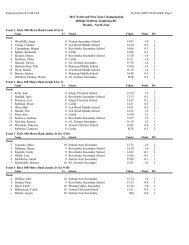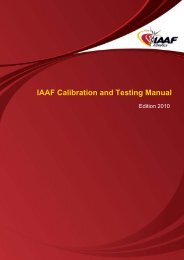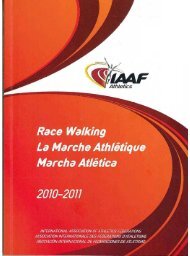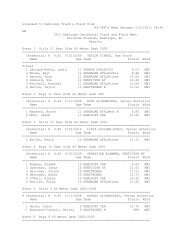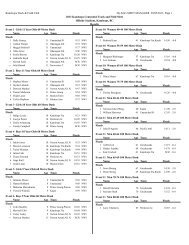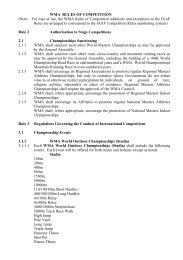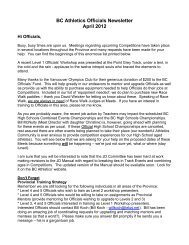IAAF Photo Finish Guidelines
IAAF Photo Finish Guidelines
IAAF Photo Finish Guidelines
Create successful ePaper yourself
Turn your PDF publications into a flip-book with our unique Google optimized e-Paper software.
<strong>IAAF</strong> <strong>Photo</strong> <strong>Finish</strong> <strong>Guidelines</strong><br />
3.1.4 The IPFJ will need to confirm whether the cameras in use have an automatic iris<br />
adjustment and aligning function. During the Championships, there is a wide<br />
range of lighting conditions between morning and evening session, the latter<br />
likely to be under floodlights. If such an automatic function is not available, then<br />
it will be necessary to enquire how accessible the cameras are to enable manual<br />
adjustments to be made, other than during a complete break in the competition<br />
sessions. The biggest problem may well lie with the infield camera which, clearly,<br />
is not accessible for manual adjustment of exposure or focus during the course of<br />
a session. As will be appreciated, the key races in terms of media interest are<br />
likely to be held during the evening session in adverse lighting conditions,<br />
coupled with strobing caused by the artificial lighting. Every effort needs to be<br />
made to make the images produced to be of the highest possible clarity.<br />
3.1.5 Contact should be made with the representative of the Service Provider<br />
responsible for the relaying of results from the terminal in the photo finish room<br />
to determine what data will be needed to identify the finishing order of the<br />
athletes. In races run in lanes, this is almost inevitably by the input of the<br />
appropriate lane number. For events not finishing in lanes, the process needs to<br />
be clearly identified.<br />
If the draw order (and corresponding leg / hip number) is to be used there needs<br />
to be a careful check that the numbers have been allocated correctly. In<br />
Championships, it is perhaps unlikely that athletes will be sharing lanes but in<br />
these instances there is always the chance that the athletes sharing the lane have<br />
been allocated leg / hip numbers the wrong way round. The Service Provider<br />
seldom seems to wish for the draw order to be utilised for inputting other than in<br />
races run wholly in lanes.<br />
If bib numbers or names are to be used for inputting, there is a greater chance of<br />
misunderstanding of the digits called, possibly four in total, if the Judge is not<br />
suitably fluent in the language being used.<br />
3.1.6 Identify if there is any form of test event or rehearsals planned prior to the first<br />
day of competition and attend such event together with the NPFJ. The rehearsal<br />
event can often be a good indicator of the level of competence and speed of<br />
decision-making by the NPFJ and may influence the level of support which will<br />
need to be provided by the IPFJ during the actual competition.<br />
3.1.7 If the photo finish system is assisted by an integrated video camera showing the<br />
finish line from a head on position, the value of such camera in the identification<br />
of athletes can be vital. As the cursor on the image on the read computer is<br />
moved, the image from the video camera is advanced to the same elapsed time<br />
automatically.<br />
It is essential that the IPFJ checks that the video camera shows the finish line at<br />
least as far out as lane 6 and that the image is suitably in focus. It is also<br />
essential the IPFJ is alert to anything which might block the image in the course<br />
of a finish. Judges, photographers and others may well not be aware of the<br />
function of such a camera and may inadvertently stray into the line of vision of<br />
that camera at a critical time during the finish of a middle distance race.<br />
The image from this camera should be made available for scrutiny in close<br />
proximity to the screen showing the image from the main photo finish camera.<br />
3.1.8 It is essential that the photo finish room is set out, as far as possible, with the<br />
screens showing the image from the “official” and the infield camera in close<br />
proximity to each other so that both may be reviewed quickly.<br />
3.1.9 Attend, if possible, the first meeting of the National Judge(s) and the Service<br />
Provider team.<br />
3.1.10 Identify the level of communication and understanding of language between the<br />
operators and the National Judge(s). If there are obvious language difficulties<br />
April 2010 2


